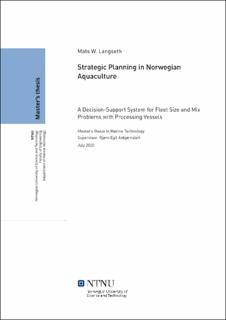| dc.contributor.advisor | Asbjørnslett, Bjørn Egil | |
| dc.contributor.advisor | Slette, Hans Tobias | |
| dc.contributor.author | Langseth, Mats Wærøe | |
| dc.date.accessioned | 2021-09-21T16:35:33Z | |
| dc.date.available | 2021-09-21T16:35:33Z | |
| dc.date.issued | 2020 | |
| dc.identifier | no.ntnu:inspera:54166542:20963699 | |
| dc.identifier.uri | https://hdl.handle.net/11250/2780164 | |
| dc.description.abstract | Grunnet tiår med enorm suksess for redere i norsk havbruk har det enda ikke vært noen stor etterspørsel etter å inkorporere grundig strategisk planlegging i langsiktig beslutningstaking. Med introduksjonen av spesialfartøy rettet mot spesifikke deler av logistikkjeden, har flåteoptimering blitt enda mer komplekst for redere. Jo flere spesialfartøy som introduseres, jo mer potensiell verdi taper rederene på å neglisjere strategisk planlegging.
På dette grunnlaget, presenterer denne rapporten et beslutningsstøttesystem for løsing av flåte-optimeringsproblemer for redere i havbruksnæringen. Systemet benytter seg av samspillet mellom optimerings- og simuleringsverktøy, hvor optimeringsmodellen utleder optimal flåte og fartøys-ruting under deterministiske operasjonstilstander ved hjelp av heltallsprogrammering, og simuleringsmodellen evaluerer flåtene under stokastiske operasjonstilstander.
Beslutningsstøttesystemet vurderer både konvensjonelle brønnbåter og mer moderne bløggebåter. I tråd med aktuelle fokusområder i næringen, utarbeider den foreslåtte løsningsmetoden den optimale flåten ved å maksimere den overordnede prestasjonen basert på fiskevelferd, utslipp og kostnadsfunksjoner. Dette involverer utarbeidelsen av funskjonelle prestasjonsparametre basert på kvantifiseringen av fiskevelferd og utslipp.
Et litteratursøk blir utført for å kartlegge moderne praksis i havbruksnæringen når det kommer til bruk av fartøy, strategisk planlegging og flåtedesign. Videre blir løsningsmetoden og utarbeidelsen av beslutningsstøttesystemet beskrevet og testet gjennom eksperimenter basert på reelle scenarier. Til slutt blir antakelser, tilkortkommenheter og systemets anvendbarhet diskutert og konkludert.
Resultatene er lovende, med gode resultater anskaffet på begrenset beregningstid. De beviser også verdien av strategisk planlegging, da den optimale flåten inkluderer både brønnbåter og bløggebåter for alle de utarbeidede testscenariene, noe som er uvanlig i dagens havbruksflåter. De setter også lys på mulige utbedringer og anvendbare utvidelser av beslutningsstøttesystemet. Disse inkluderer implemetasjonen av en rutingsheuristikk i simuleringsmodellen for å bedre ta høyde for det underliggende taktiske planleggingproblemet, og forskning på den konkrete effekten av havbruksoperasjoner på fiskevelferd samt den overordnede verdien av fiskevelferd. | |
| dc.description.abstract | With decades of vast success for shipowners in the Norwegian aquaculture industry, there has so far not been a strong push to incorporate comprehensive strategic planning into long-term decision-making. However, the introduction of specialized vessels for specific parts of the salmon supply chain has caused the fleet size and mix problem to become increasingly complicated for shipowners. The more special vessels that are introduced, the more value shipowners are potentially giving up by neglecting thorough strategic planning.
On these grounds, this thesis presented a decision-support system for solving maritime fleet size and mix problems for shipowners in the aquaculture industry. The system is based on the collaboration of optimization and simulation tools, where the optimization model derives the optimal fleet size and mix and vessel routing for deterministic operating conditions using integer programming, and the simulation model evaluates the derived fleets in stochastic operating conditions.
The decision-support system considers both conventional well-boats and the more recent processing vessels. In keeping with recent focus areas in the industry, the proposed method derives the optimal fleet size and mix by maximizing the overall performance of the fleet, evaluating fish welfare impacts and emission output as well as costs. This involves deriving functional performance parameters based on the quantification of fish welfare impacts and emissions.
A literature review is performed, determining the state of the art within Norwegian aquaculture, considering the deployed vessels and common practice for strategic planning and fleet design. Further, the proposed method and the construction of the decision-support system is described, before the system is demonstrated and analyzed in a feasibility study. Finally, assumptions, shortcomings and the system's applicability are discussed and concluded.
The results of the feasibility study are promising, with realistic results being derived while limiting computational time. They prove the value of strategic planning, as the derived optimal fleets included both well-boats and processing vessels for all tested cases, which is uncommon for fleets in the industry today. Further, the derived results highlight possible improvements and extensions applicable to the decision-support system. These include implementing routing heuristics to the simulation model to better account for the underlying tactical planning problem, and carrying out more extensive research on fish welfare impacts during specific operations and the overall value of fish welfare. | |
| dc.language | | |
| dc.publisher | NTNU | |
| dc.title | Strategic Planning in Norwegian Aquaculture:
A Decision-Support System for Fleet Size and Mix Problems with Processing Vessels | |
| dc.type | Master thesis | |
